A History of Thanksgiving Day: The Pilgrims of Plymouth
In England in the early 1600s, it was illegal to be a member of any other church than the Church of England. Some English believers, who thought the Church of England did things that were against God’s will, wanted to purify the church and make it like it was when the apostles were still alive. These believers were known as Puritans. Other English believers thought they should separate completely from the Church of England. Those believers were called Separatists.
At the time, the government of The Netherlands allowed people to worship God with more freedom than the government of England did. In 1608 about 30 Separatists from the English town of Scrooby made the difficult decision to leave their homes and move to The Netherlands where they would be safe from persecution. No one was allowed to leave England without permission from the king, so they left in secret.

Scrooby England. Steel engraving by A. Willmore,
published in The Pilgrim Fathers by William Henry Barlett,
London, 1853. Courtesy of the Library of Congress.
William Bradford and William Brewster were two leaders of these Separatists. Bradford was the first person to use the word Pilgrim as a name for the Separatists living in The Netherlands. Brewster had formerly worked on the staff of an English diplomat to The Netherlands and later as a bailiff and a postmaster.
The Pilgrims struggled to make a living in The Netherlands. After residing there a few years, they became afraid that their children would begin to speak Dutch, the language of The Netherlands. They were also afraid that the children would follow Dutch customs instead of English ones. Some of the Separatists decided to emigrate to America. Several went back to England to get ready for their trip across the Atlantic.
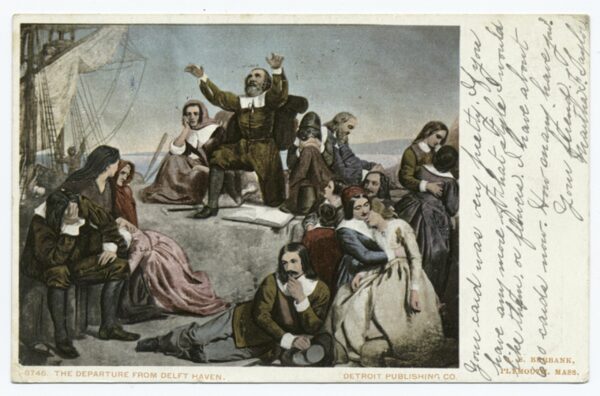
Postcard illustrating the Pilgrims leaving The Netherlands.
Courtesy of The Miriam and Ira D. Wallach Division of Art,
Prints and Photographs: Photography Collection,
The New York Public Library.
Pilgrim John Carver made arrangements for the group’s travel across the Atlantic. The Pilgrims couldn’t afford to make the trip and begin a village on their own, so they joined with other English people who wanted to go to America. Businessmen agreed to pay for their trip and also for things they would need in America. In return the Pilgrims and other English settlers would ship fish, furs, and timber back to England.
On September 16, 1620, 102 men, women, and children gathered in Plymouth, England, and boarded two ships, the Speedwell and the Mayflower. Less than half were Pilgrims.
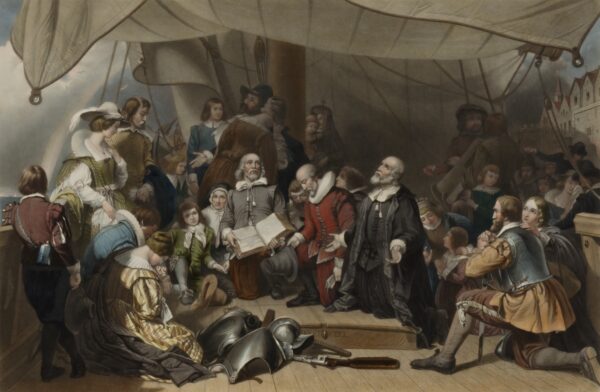
Embarkation of the Pilgrims [on the Speedwell] by Samuel Bellin;
Copy after Robert Walter Weir. Courtesy of the
Smithsonian American Art Museum,
Gift of International Business Machines Corporation.
The Speedwell leaked, so all of the travelers crowded onto the Mayflower. A baby boy was born on the voyage. His parents named him Oceanus Hopkins. The Mayflower dropped anchor on November 11, 1620, on the coast of Cape Cod in what is now Massachusetts.
All of the men signed an agreement while they were still on the ship. The agreement stated that they would form a government and that each of them would obey the laws they made. The settlers agreed to live according to what the majority decided. The passengers elected John Carver to be their first governor. They called their agreement the Mayflower Compact.

The pilgrims signing the compact on board the Mayflower,
painted by T.H. Matteson, engraved by Gauthier.
Courtesy of the Library of Congress.
For the next month, the Pilgrims and other passengers explored along Cape Cod. They went ashore near the western edge of Cape Cod on December 21. According to one story, the passengers stepped out onto a large rock. People call that rock Plymouth Rock. The oldest written record of that story dates from the early 1700s.

The Landing of the Fathers at Plymouth by Thomas Eayrs
shows John Carver, William Bradford, William Brewster, and others
in a rowboat making their way to the shore.
Courtesy of the Sminthsonian Institution,
Harry T. Peters “America on Stone” Lithography Collection.
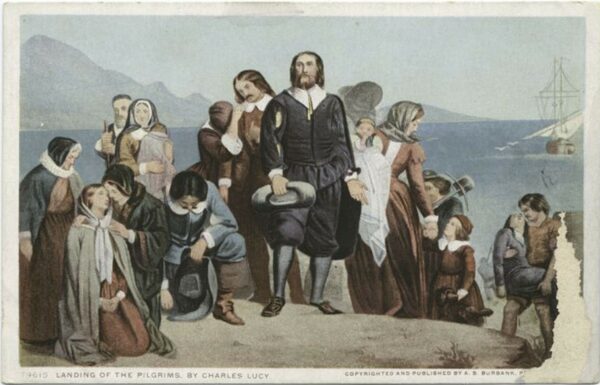
Postcard illustrating the landing of the Pilgrims.
Courtesy of The Miriam and Ira D. Wallach Division
of Art, Prints and Photographs: Photography Collection,
The New York Public Library.
Together the Pilgrims and other immigrants built a settlement, while continuing to live on the ship. They named the village Plymouth after the English city they had left three months before. Plymouth was the first permanent English settlement in New England. Cold New England winters made December a difficult time to begin a settlement. The Pilgrims had little shelter and no harvest. Many died that first winter.
The Pilgrims met two members of the Wampanoag Nation, Massasoit and Squanto, and an Abenaki man named Samoset. The Wampanoag lived in the region where the Pilgrims settled. Massasoit was their sachem.
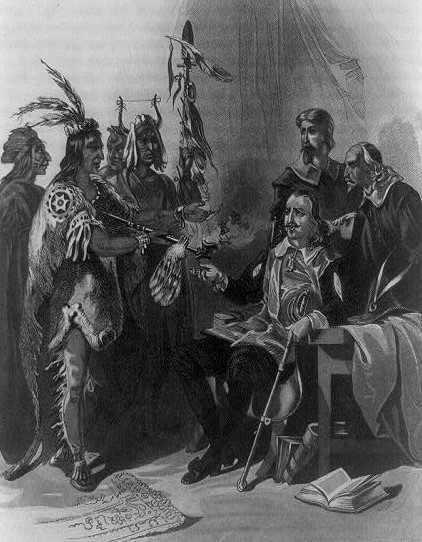
Meeting of Governor Carver and Massasoit,
drawn by H.L. Stevens, engraved by Augustus Robin.
Courtesy of the Library of Congress.
When the Pilgrims arrived, Samoset was visiting Massasoit. Samoset had come south from his home in the area that later became Maine. By this time, many European ships were bringing fishermen to the northern coasts of North America. Many of these ships were English. Samoset had learned English from some of these fishermen.
Around 1585 a Wampanoag woman had given birth to a baby boy. His family named him Squanto. When Squanto was young, an Englishman came to the area where Squanto’s family lived. He captured Squanto, enslaved him, and took him to Spain. Squanto escaped and went to England. In 1619 Squanto sailed back to America on an English ship. When he arrived, he learned that the people in his village had died from a plague. When the Pilgrims arrived in 1620, Squanto was living nearby. Samoset introduced Squanto to the Pilgrims. Squanto became a friend to the Pilgrims. He helped them greatly. He taught them how to plant corn, how to fish, how to trap animals for their fur, and how to survive in their new home. In 1621 Plymouth governor John Carver and Massasoit made a treaty. Squanto served as their interpreter. A few days later the Mayflower returned to England.
The next year Squanto led William Bradford and other settlers on a trip around Cape Cod. Squanto got sick and died while they were on the trip. He was about 37 years old. When he died, he wanted the governor to pray for him that he “might go to the Englishmen’s God in Heaven.” Squanto blessed the Pilgrims during his four short years back in his homeland. His story was like that of Joseph in the Bible. Joseph’s brothers did evil when they sold him as a slave. The Englishman did evil to Squanto when he enslaved him. In both cases, God brought good out of bad.
John Carver died in April 1621. Plymouth residents elected William Bradford as their new governor. He would be elected a total of 30 times. Except for five years, he served from 1621 to 1656.
In the fall of 1621, Bradford invited Massasoit and some of his nation’s men to a celebration. They thanked God for sustaining them through hard times. This is the historical beginning of our modern Thanksgiving.
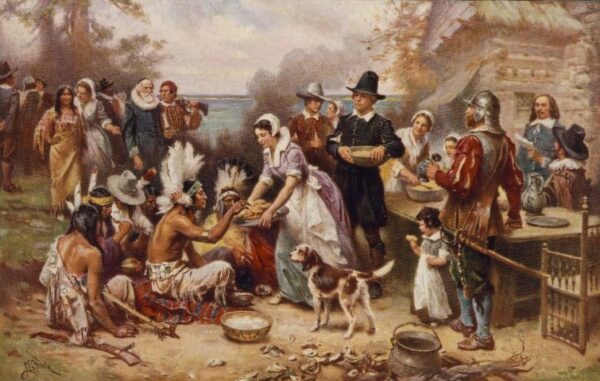
The First Thanksgiving 1621 by J.L.G. Ferris.
Courtesy of the Library of Congress.
Homeschooling mamas have daily opportunities to help their children know the Source of all our harvest blessings—and all of our other blessings, too—and to demonstrate to their children how to have a thankful heart.
The earth has yielded its produce;
God, our God, blesses us.
God blesses us,
That all the ends of the earth may fear Him.
Psalm 67:6-7

